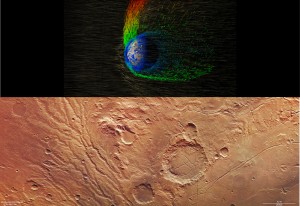
Rob Lillis is an Associate Research Physicist at the University of California Berkeley Space Sciences Laboratory, a member of the MAVEN Science team and the deputy lead for the Solar Energetic Particle instrument.
Why is the surface of Mars no longer habitable?
Sounds like a straightforward question, right? However, those nine words comprise one of the most vexing questions in planetary science. There is now overwhelming evidence that Mars was once a place where liquid water flowed on the surface and, thus, life as we know it could have thrived, at least episodically. Orbiters have identified branching networks of valleys that most likely were carved by rainwater or snowmelt. Rovers have driven through ancient streambeds and found minerals that can only be formed over many years underwater. However, such stable surface water requires an atmospheric surface pressure much higher than today’s ~7 millibars (<1% of Earth’s pressure) to prevent evaporation and cause greenhouse warming.
Where did this ancient atmosphere go? If it had all been absorbed back into the crust, abundant carbonate minerals should exist on or near the surface. However, extensive surveys of Mars from orbit have revealed very little carbonate, not nearly enough to account for all the carbon dioxide that has been lost. The only other explanation: The atmosphere escaped out to space over billions of years. But how did this happen? What physical processes drove the escape? How did they vary over time as solar radiation and the solar wind buffeted Mars’ atmosphere, which lacked the protection of a global magnetic field? And, most importantly, how much total atmosphere escaped over Mars’ history?
These are the questions that motivate the MAVEN team’s scientific efforts—day in and day out—as we analyze and interpret data from our nine science instruments. Our overarching strategy is to use MAVEN’s observations to understand the processes that cause atmosphere to escape out into space, as they operate under the conditions experienced by present-day Mars. We will then combine that with knowledge of how those conditions have varied over time to estimate the total loss of atmosphere. Sounds simple, right? But as always, and as you probably guessed, the devil is in the details. Or should I say devils?
The first devil is that MAVEN directly measures escaping ions, i.e., particles with a positive electrical charge, but no instrument yet exists to directly detect escaping neutral (uncharged) particles. Therefore we must infer their escape rates indirectly, and we do this in two complementary ways. The first way is by measuring densities and temperatures of neutrals, electrons, and ions, as MAVEN swoops through the upper atmosphere on each orbit, as well as downward-traveling energetic ions (these can “splash out” neutral atoms, like a child jumping into a ball pit, in a process known as sputtering). These quantities let us calculate the rate at which upward-traveling energetic atoms are produced and their rates of escape.
The second way is to observe the faint ultraviolet glow of neutral oxygen and hydrogen high above Mars and use computer simulations of these same reactions and upward passage to estimate the fraction of these particles which are gravitationally bound to Mars versus those which have sufficient energy to escape. Overall, these approaches allow us to characterize the rates of neutral and ion escape from Mars under a variety of seasonal and space weather conditions experienced by Mars in the current epoch.
The second devil is that MAVEN can’t be everywhere at once. As MAVEN’s orbit around Mars gradually changes over time and Mars rotates beneath that orbit, we measure and infer rates of escape at a range of discrete locations under different drivers. In other words, we need a way to “fill in the gaps” in our observations to estimate the global rates of escape and their variability. To do this, we employ sophisticated 3-D simulations of the Martian atmosphere and its interaction with the solar wind. By comparing and matching simulated escape rates to those measured at MAVEN’s location under the same drivers, we can be confident that the global escape rates predicted by these validated simulations reflect reality for present-day Mars.

Which brings us to our third devil. These validated global escape rates will be most reliable for the current Mars atmosphere, under the range of solar drivers that MAVEN has characterized. As we turn the clock backward, three issues confound us. First, solar extreme ultraviolet (EUV) radiation and solar wind intensities vary over the 11 year solar activity cycle and unfortunately the most recent cycle was much weaker than normal. Therefore we have not yet characterized their full range that is relevant for the ‘recent’ past (i.e. several million years). Second, these same quantities have decreased gradually over the history of the sun. In the ‘distant’ past (i.e. billions of years) they were at much higher levels that MAVEN will not observe. Third, the atmosphere’s pressure was higher and its composition has changed over time due to this escape. To reliably estimate escape rates under these very different conditions, we will need further 3-D simulations that leverage our hard-won physical understanding of the ion and neutral escape processes occurring in the present-day. The result will be a robust picture of escape rates under the wide range of conditions that likely existed over solar system history.
It should be clear that this approach is ‘bedeviled’ with assumptions and uncertainties. Luckily, MAVEN has one more card to play to determine atmospheric loss: its ability to measure isotopes, i.e. ‘versions’ of the same element with different atomic weights. Escape processes typically favor the lighter isotopes, so by measuring the ratios of light to heavy ones in Mars’ atmosphere today, we can constrain the total amount of that element that has escaped over time.
With this multifaceted approach, the MAVEN science team is continuing to work towards a progressively better understanding of the history of escape rates of the Martian atmosphere—and hence of the atmosphere itself—back to a time almost four billion years ago, when the surface of Mars was suitable for life as we know it.

